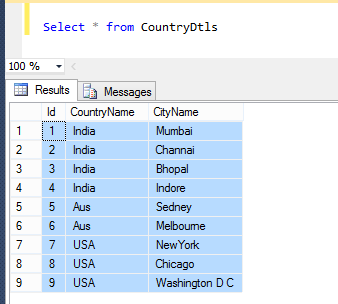Introduction
We use pivot queries when we need to transform data from row-level to columnar data. But what would happen when someone ask to pivot table without using pivot function in sql. This scenario can be achieved by CTE (Common Table Expressions) and MAX case combination.
Background
This post intends to help T-SQL developers for solving interview question, and I am sure many of you must have came across this question several times in the past.
This approach becomes more helpful when we are working on other SQL workbench where there is no pivot function exist. such as Amazon redshift
Using the Code
Step 1: Create the test table. for this you can use scripts shown below
USE [Your Database Name]
GO
SET ANSI_NULLS ON
GO
SET QUOTED_IDENTIFIER ON
GO
CREATE TABLE [dbo].[CountryDtls](
[Id] [int] NOT NULL,
[CountryName] [nvarchar](50) NULL,
[CityName] [nvarchar](50) NULL,
CONSTRAINT [PK_CountryDtls] PRIMARY KEY CLUSTERED
(
[Id] ASC
)WITH (PAD_INDEX = OFF, STATISTICS_NORECOMPUTE = OFF, IGNORE_DUP_KEY = OFF, ALLOW_ROW_LOCKS = ON, ALLOW_PAGE_LOCKS = ON) ON [PRIMARY]
) ON [PRIMARY]
GO
INSERT [dbo].[CountryDtls] ([Id], [CountryName], [CityName]) VALUES (1, N'India', N'Mumbai')
INSERT [dbo].[CountryDtls] ([Id], [CountryName], [CityName]) VALUES (2, N'India', N'Channai')
INSERT [dbo].[CountryDtls] ([Id], [CountryName], [CityName]) VALUES (3, N'India', N'Bhopal')
INSERT [dbo].[CountryDtls] ([Id], [CountryName], [CityName]) VALUES (4, N'India', N'Indore')
INSERT [dbo].[CountryDtls] ([Id], [CountryName], [CityName]) VALUES (5, N'Aus', N'Sedney')
INSERT [dbo].[CountryDtls] ([Id], [CountryName], [CityName]) VALUES (6, N'Aus', N'Melbourne')
INSERT [dbo].[CountryDtls] ([Id], [CountryName], [CityName]) VALUES (7, N'USA', N'NewYork')
INSERT [dbo].[CountryDtls] ([Id], [CountryName], [CityName]) VALUES (8, N'USA', N'Chicago')
INSERT [dbo].[CountryDtls] ([Id], [CountryName], [CityName]) VALUES (9, N'USA', N'Washington D C')
Step 2: After executing the script. your table will look like this:
Select * from CountryDtls

Step 3: Now find a column in your table which has common value. In our case column [countryName] has common values- see the image for this

Step 4: Once you have found the column name containing same value . Apply ROW_NUMBER() function over this column. in our case column [countryName] is containing same value so data will be partitioned by this column- see the image for this

Step 5 : Now after the partition we create CTE(Common Table Expressions) where CTE is kind of temporary table that can be used for writing recursive queries.
- Put our sub query inside the CTE
- Get the Max value of column [Row_no]. In our case it is 4, so we have to create 4 columns such as (
[city_1] [city_2], [city_3], [city_4])
;with CTE_tbl as
(
SELECT CountryName,CityName,
ROW_NUMBER() OVER(PARTITION BY CountryName order by CountryName Desc) as row_no
FROM CountryDtls
)
select
CountryName
, Max(case when row_no=1 then cityName end )as City_1
, Max(case when row_no=2 then cityName end )as City_2
, Max(case when row_no=3 then cityName end )as City_3
, Max(case when row_no=4 then cityName end )as City_4
FROM CTE_tbl
group By CountryName
Step 6: Finally see the output

Step 7: I am frequently being asked the question that what will happen when we add an extra row in country table?
For example: if we add another city name in country table then our query will not work properly. well this is relevant question but we have solution for this
- When we say city is added to the table and not to our CTE? It means table is dynamic so our CTE must be dynamic, to achieve this we will have to find the max value of column
[row_no]. - We use table type variable (In our case @TatalRows is table type variable) to store all values of column
[row_no] . - Then get max value from
@TatalRows(table type variable). - Then we use while loop to create dynamic column name and store it into local variable
@DynamicColumnName. - Create dynamic query and place the dynamic column name(
@DynamicColumnName) in right place
Below are the Dynamic query for pivoting data you can add extra row in country table and see the result:
declare @maxColumnCount int=0;
declare @Query varchar(max)='';
declare @DynamicColumnName nvarchar(MAX)='';
DECLARE @TotalRows TABLE( row_count int)
INSERT INTO @TotalRows (row_count)
SELECT (ROW_NUMBER() OVER(PARTITION BY CountryName order by CountryName Desc)) as row_no FROM CountryDtls
set @maxColumnCount= (select max(row_count) from @TotalRows)
DECLARE @cnt INT = 1;
WHILE @cnt <= @maxColumnCount
BEGIN
set @DynamicColumnName= @DynamicColumnName + ', Max(case when row_no= '+cast(@cnt as varchar)+' then cityName end )as City_'+cast(@cnt as varchar)+''
SET @cnt = @cnt + 1;
END;
set @Query='
with CTE_tbl as
(
SELECT CountryName,CityName,
ROW_NUMBER() OVER(PARTITION BY CountryName order by CountryName Desc) as row_no
FROM CountryDtls
)
select
CountryName
'+@DynamicColumnName+'
FROM CTE_tbl
group By CountryName'
execute (@Query)
